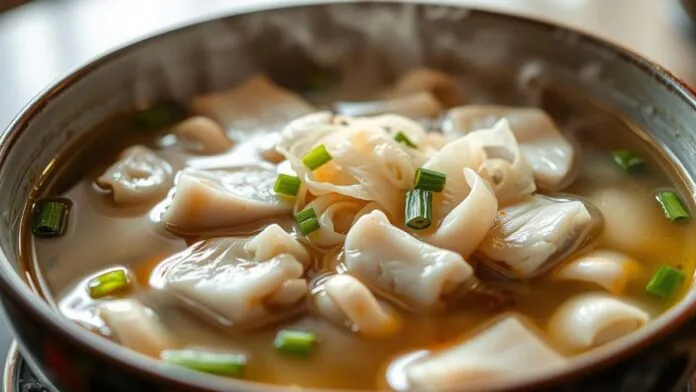Did you know fish maw soup is a treasured part of Chinese cuisine? It’s often enjoyed at big events like Lunar New Year and weddings. The dish features fish maw, which comes from a fish’s swim bladder. It’s soft and gelatinous.
Making this gourmet soup takes hours. This shows its deep cultural value and complex cooking process.
Fish maw soup is not just tasty. It’s also good for you. It has lots of collagen, which helps your skin and joints. Let’s dive into making this traditional recipe together.
What is Fish Maw Soup?
Fish maw soup is a beloved dish in Chinese cuisine. It’s known for its rich flavor and health perks. The soup uses fish maw, the swim bladder of fish, which is packed with collagen.
The broth is made with a mix of ingredients. This makes it both nourishing and versatile.
Definition and Ingredients
The key ingredient in fish maw soup is dried fish maw. It needs to soak for hours or even overnight before cooking. Other important parts include:
- Chicken stock (typically around 3 liters)
- Fried fish maw (100 grams)
- Frozen crab meat (500 grams)
- Eggs (3)
- Potato starch (5 tablespoons)
Cooking the broth can take different times. It depends on the fish maw’s quality and type. Good fish maw should feel slippery and smooth after cooking.
Why is it Popular?
Fish maw soup is a big hit in Chinese culture. It’s often served at special events like Lunar New Year banquets and weddings. It’s seen as a sign of prosperity and good luck.
It’s also loved by those who care about their health. The collagen in fish maw is great for the skin and joints. Its cultural value and health benefits keep it popular in Chinese cuisine.
Health Benefits of Fish Maw Soup
Fish maw soup is packed with health benefits. It’s rich in collagen, which is good for your skin and joints. It also has a lot of protein, helping your muscles grow and repair.
This makes fish maw soup a great choice for anyone looking to improve their health. It’s a nutritious addition to any meal.
Nutritional Value
Fish maw is a nutritional powerhouse. It has about 24-27 grams of protein in every 30-gram serving. This is a lot of protein, making it a great meat substitute.
It’s also very low in fat, with only 0-1 gram per serving. This makes it perfect for those watching their fat intake. It’s a healthy broth that’s easy to fit into a low-fat diet.
Low in Fat and High in Protein
Fish maw soup is a smart choice for a healthy meal. It’s low in fat and high in protein. This makes it great for anyone looking to eat well.
The glycosaminoglycans in fish maw help your skin, bones, and connective tissues grow strong. Eating this soup is not only good for you but also delicious.
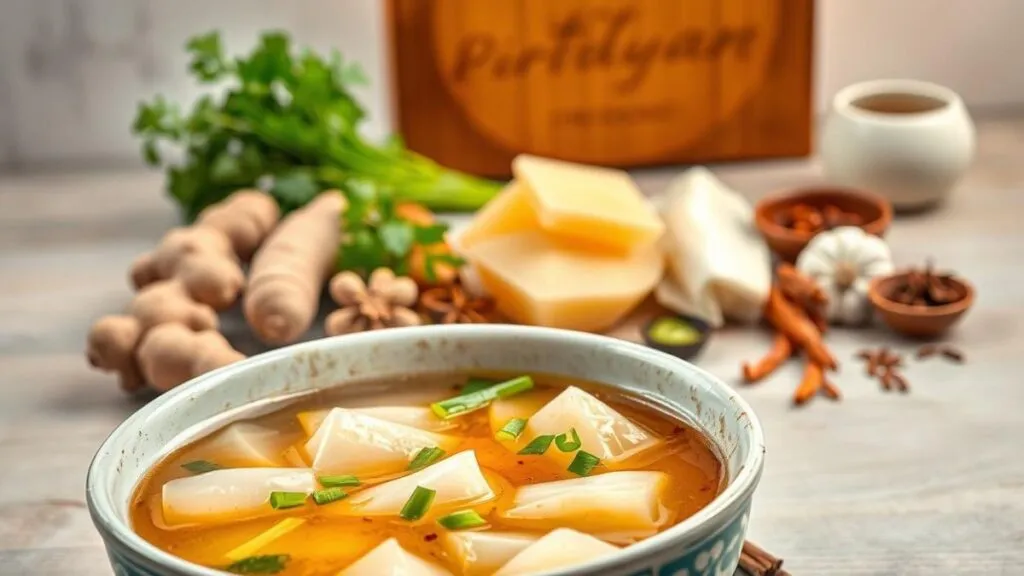
Ingredients for Delicious Fish Maw Soup
Making a tasty fish maw soup means knowing both common and alternative ingredients. This knowledge helps make the soup both traditional and tailored to your taste. It also makes sure you can find the ingredients easily.
Common Ingredients
For a classic fish maw soup, you’ll need:
- Dried fish maw – about 80g, soaked for at least 4 hours
- Crab meat – around 100g of claw meat adds flavor
- Chicken stock – 800 ml makes the broth rich
- Ginger – 3 slices, cut thin for a fragrant touch
- Dried mushrooms – 4 large pieces, soaked in hot water
- Dried scallops – 2 to 3 large pieces, soaked until soft
- Seasoning – includes salt (½ tsp), sugar (¼ tsp), fish sauce (1 tsp), and soy sauce (2 tsp)
- Corn starch – 3 tbsp mixed with 4 tbsp of water for thickening
- Garnish – 2 stalks of chopped spring onion for a fresh finish
Alternative Ingredients
Want to try something new? Here are some alternatives:
- Sea cucumber can replace fish maw for a different texture
- Vegetable stock is a good substitute for chicken stock, great for vegetarians
- Different types of seafood like shrimp or scallops can be used, depending on what’s available
Each alternative adds unique flavors and health benefits. By mixing and matching, you can create a special version of this traditional soup.
Preparing the Fish Maw Soup
Preparing fish maw soup is a detailed process. It starts with soaking the fish maw and making the broth. These steps are key to a rich and flavorful dish.
Preparation Steps
First, soak the fish maw in cold water for at least 4 hours. This step is vital to make the fish maw tender. After soaking, cut it into smaller pieces. Here are the main steps:
- Soak the fish maw in cold water for a minimum of 4 hours.
- After soaking, cut the fish maw into smaller pieces.
- Soak 4 large dried scallops in fresh water for about 30 minutes until softened.
- Julienne the optional dried shiitake mushrooms if using.
Cooking Instructions
Now, let’s move to cooking. Start by boiling 1 liter of chicken broth and 500ml of water in a large pot. This will be the soup base. Add ginger slices and the prepared fish maw to the boiling liquid. Here are the cooking steps:
- Bring 1 liter of chicken broth and 500ml of water to a boil in a large pot.
- Add 2 slices of fresh ginger and the cut fish maw to the boiling liquid.
- Simmer for 40 minutes, allowing the flavors to develop.
- Incorporate other ingredients like crab meat, scallops, and optional mushrooms.
- Season with ½ teaspoon salt, ½ teaspoon sugar, 1 teaspoon fish sauce, and 2 teaspoons soy sauce.
- Create a cornstarch slurry using 3 tablespoons of cornstarch mixed with 4 tablespoons of water; add this to the pot to thicken the soup.
Let the mixture simmer for another 15 minutes before serving. This fish maw soup is not just warm but also a culinary delight.
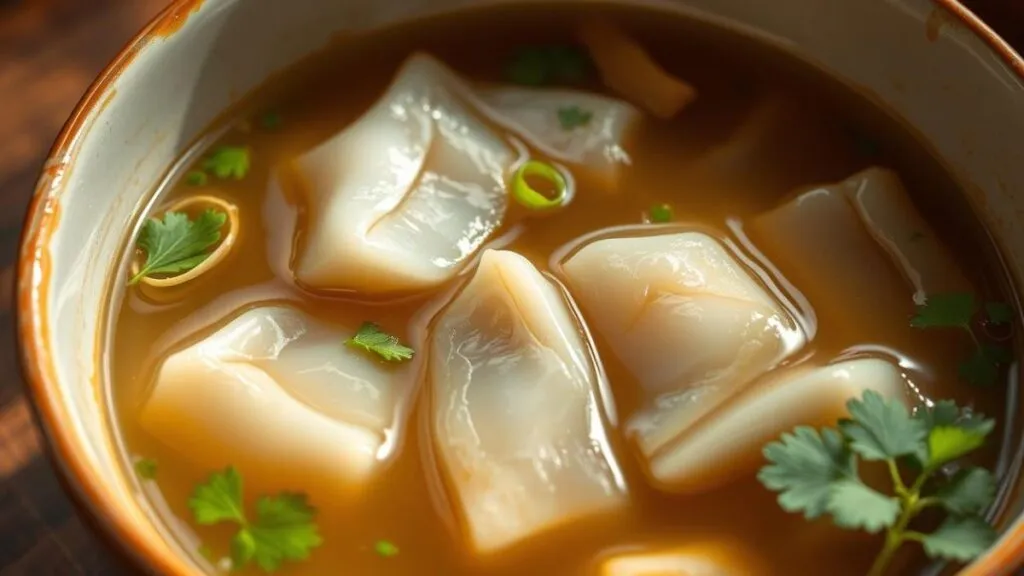
Serving Suggestions and Tips
When serving fish maw soup, think about how to make it look and taste great. Serving it hot in fancy bowls makes it more appealing. It also makes guests eager to try it.
Best Ways to Serve
To make it look better, garnish with green onion for color and freshness. A bit of white pepper can also boost the flavor. For a full meal, serve with steamed rice or crispy fried bread to soak up the broth.
Try adding kimchi or pickled vegetables for a unique twist. This adds different textures and tastes.
Cooking Tips
Simmer the soup gently to keep flavors in. This way, the ingredients blend well. Soak dried fish maw in hot water for 30 minutes to soften it.
To thicken the soup, add a potato starch mixture slowly. Then, bring it to a boil again. This keeps the flavors delicate and the soup thick.
| Serving Style | Description | Accompaniments |
|---|---|---|
| Elegant Bowls | Serve in aesthetically pleasing bowls | Steamed rice, fried bread |
| Garnishing | Top with chopped green onion and white pepper | Kimchi, pickled vegetables |
| Temperature | Best enjoyed hot to maximize flavor | Warm tea or drinks |
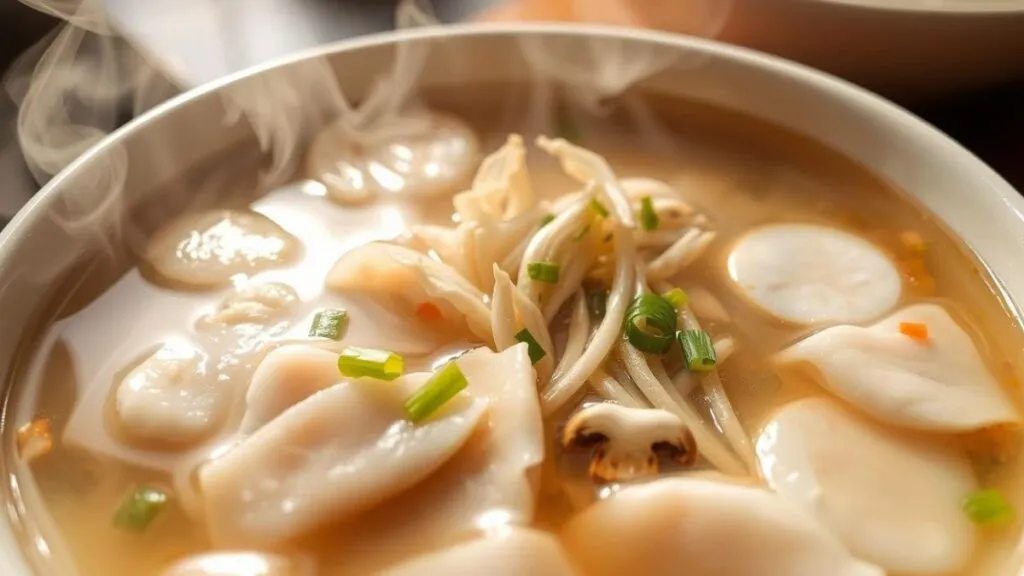
Conclusion
My journey into fish maw soup has shown it’s more than a dish. It’s a culinary experience filled with tradition and flavor. Fish maw, a costly ingredient, is celebrated for its versatility and nutritional value.
Its unique flavor not only pleases the taste buds but also brings people together. Whether it’s during Lunar New Year or intimate gatherings, making fish maw soup is rewarding. You can swap ingredients like napa cabbage and proteins to make it your own.
With over 1500 recipes on Pinterest, the possibilities are endless! I encourage you to try this fish maw soup recipe in your kitchen. It’s perfect for festive occasions or a comforting meal. Every spoonful celebrates taste and health, making it truly remarkable.
FAQ
What is fish maw?
Fish maw is the dried swim bladder of large fish, like croaker and sturgeon. It’s a key ingredient in fish maw soup. It’s prized for its gelatinous texture and health benefits.
How do I soak the fish maw before cooking?
To soak the fish maw, put it in cold water for several hours or overnight. This softens it, making it easier to cut into smaller pieces for your soup.
Can I use other types of meat in fish maw soup?
Yes, you can use other meats. Chicken is common, but you can also add seafood like crab meat. Even different proteins like sea cucumber can enhance the flavor.
What are the health benefits of fish maw soup?
Fish maw soup is rich in collagen, which supports skin and joint health. It’s also high in protein and low in fat, making it a nutritious meal.
What flavors can I enhance the soup with?
You can add flavors like ginger, white pepper, and a splash of soy sauce. These ingredients add depth to the soup.
When is fish maw soup traditionally served?
Fish maw soup is served at special occasions like Lunar New Year and weddings. It symbolizes prosperity and good fortune.
How should I serve fish maw soup for best presentation?
Serve the soup hot in elegant bowls. Garnish with chopped green onions for color and flavor. This improves both the presentation and the taste.
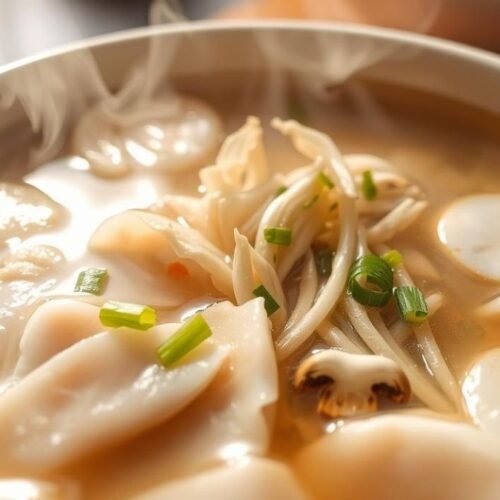
Fish Maw Soup Recipe
Ingredients
- 80 g dried fish maw soaked for at least 4 hours
- 100 g crab meat
- 800 ml chicken stock
- 3 slices of ginger
- 4 large dried mushrooms soaked in hot water
- 2 to 3 large dried scallops soaked until soft
- ½ tsp salt
- ¼ tsp sugar
- 1 tsp fish sauce
- 2 tsp soy sauce
- 3 tbsp cornstarch mixed with 4 tbsp water for thickening
- 2 stalks of chopped spring onion for garnish
Instructions
- Soak the fish maw in cold water for at least 4 hours.
- After soaking, cut the fish maw into smaller pieces.
- Soak 4 large dried scallops in fresh water for about 30 minutes until softened.
- Julienne the optional dried shiitake mushrooms if using.
- In a large pot, bring 1 liter of chicken broth and 500ml of water to a boil.
- Add 2 slices of fresh ginger and the cut fish maw to the boiling liquid.
- Simmer for 40 minutes.
- Add crab meat, scallops, and optional mushrooms.
- Season with salt, sugar, fish sauce, and soy sauce.
- Create a cornstarch slurry with 3 tablespoons of cornstarch and 4 tablespoons of water. Add this to the pot and let the soup thicken.
- Simmer for another 15 minutes before serving.
Notes
- For alternative ingredients: sea cucumber can replace fish maw for a different texture, and vegetable stock can be used for a vegetarian version.
- Make sure to soak the fish maw for the appropriate time to ensure it’s tender.
- Use cornstarch to thicken the soup, adding it gradually to avoid clumping.
- For enhanced flavor, you can serve with steamed rice, fried bread, or kimchi.

